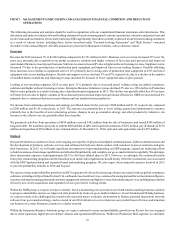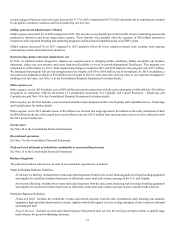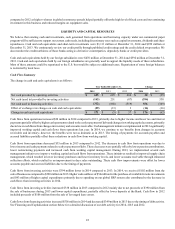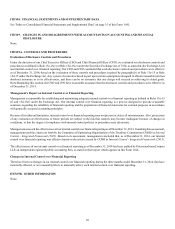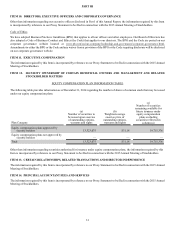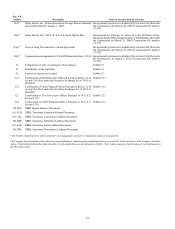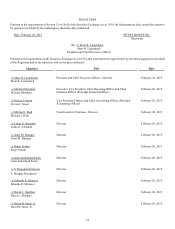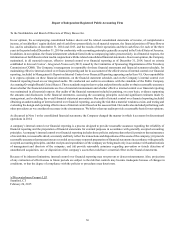Pitney Bowes 2014 Annual Report Download - page 36
Download and view the complete annual report
Please find page 36 of the 2014 Pitney Bowes annual report below. You can navigate through the pages in the report by either clicking on the pages listed below, or by using the keyword search tool below to find specific information within the annual report.26
future returns for the portfolio, management places more emphasis on the expected future returns than historical returns. The expected
rate of return on plan assets used in the determination of net periodic pension expense for 2014 was 7.0% for the U.S. Plan and 7.5% for
the U.K. Plan. For 2015, the expected rate of return on plan assets used in the determination of net periodic pension expense for both the
U.S. Plan and the U.K. Plan will be 7.0%. A 0.25% change in the expected rate of return on plan return on assets would impact annual
pension expense for the U.S. Plan by $4 million and the U.K. Plan by $1 million. See Note 13 to the Consolidated Financial Statements
for information about the allocation of pension assets.
In October 2014, the Society of Actuaries published updated mortality tables for U.S. plans (RP-2014) and an updated improvement scale
(MP-2014), which both reflect improved longevity. We have historically utilized the Society of Actuaries' published mortality data in our
plan assumptions. Accordingly, we adopted RP-2014 and MP-2014 for purposes of measuring pension and other postretirement benefit
obligations at year end. The change to the mortality assumption increased the year-end pension and other postretirement obligation by
an aggregate $119 million.
Actual pension plan results that differ from our assumptions and estimates are accumulated and amortized over the life expectancy of
inactive plan participants and affect future pension expense. Net pension expense is also based on a market-related valuation of plan
assets where differences between the actual and expected return on plan assets are recognized in the calculation of the market-related
value of assets over a five-year period. At December 31, 2014, plan benefits for participants in a majority of our U.S. and foreign pension
plans were frozen.
Residual value of leased assets
We provide lease financing for our products primarily through sales-type leases. Equipment residual values are determined at inception
of the lease using estimates of equipment fair value at the end of the lease term. Residual value estimates impact the determination of
whether a lease is classified as an operating lease or a sales-type lease. Estimates of future equipment fair value are based primarily on
our historical experience. We also consider forecasted supply and demand for our various products, product retirement and future product
launch plans, end of lease customer behavior, regulatory changes, remanufacturing strategies, used equipment markets, if any, competition
and technological changes.
We evaluate residual values on an annual basis or sooner if circumstances warrant. Declines in estimated residual values considered
"other-than-temporary" are recognized immediately. Estimated increases in future residual values are not recognized until the equipment
is remarketed. If the actual residual value of leased assets were 10% lower than management's current estimates, pre-tax income would
be lower by $12 million.
Allowances for doubtful accounts and credit losses
We estimate our credit risk for accounts receivables and finance receivables and provide allowances for estimated losses. We believe that
our credit risk is limited because of our large number of customers, small account balances for most of our customers and customer
geographic and industry diversification. We continuously monitor collections and payments from our customers and evaluate the adequacy
of the applicable allowance based on historical loss experience, past due status, adverse situations that may affect a customer's ability to
pay and prevailing economic conditions. We make adjustments to the reserves as deemed necessary. This evaluation is inherently subjective
and actual results may differ significantly from estimated reserves.
The allowance for doubtful accounts as a percentage of trade receivables was 2.5% at December 31, 2014 and 2.7% at 2013. Holding all
other assumptions constant, a 0.25% change in the allowance rate at December 31, 2014 would have changed the 2014 provision by $1
million.
Total allowance for credit losses as a percentage of finance receivables was 1.5% at December 31, 2014 and 1.8% at 2013. Holding all
other assumptions constant, a 0.25% change in the allowance rate at December 31, 2014 would have changed the 2014 provision by $5
million.
Income taxes and valuation allowance
We are subject to income taxes in the U.S. and numerous foreign jurisdictions. Our annual tax rate is based on our income, statutory tax
rates, tax reserve changes and tax planning opportunities available to us in the various jurisdictions in which we operate. Significant
judgment is required in determining our annual tax rate and in evaluating our tax positions.
We regularly assess the likelihood of tax adjustments in each of the tax jurisdictions in which we have operations and account for the
related financial statement implications. Tax reserves have been established which we believe to be appropriate given the possibility of
tax adjustments. Determining the appropriate level of tax reserves requires us to exercise judgment regarding the uncertain application


